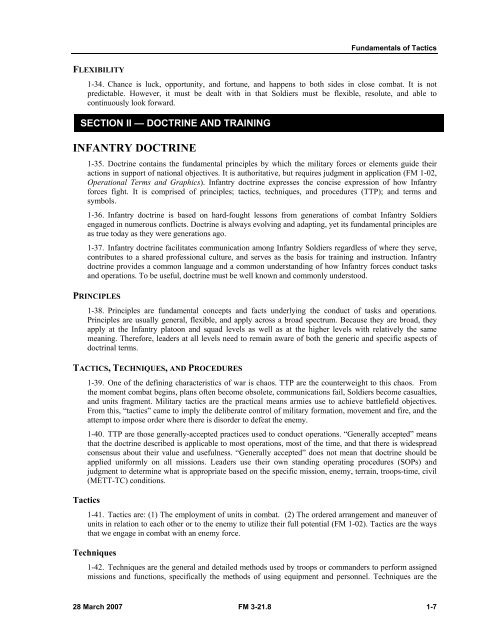Infantry Rifle Platoon and Squad - Sakai
Infantry Rifle Platoon and Squad - Sakai
Infantry Rifle Platoon and Squad - Sakai
You also want an ePaper? Increase the reach of your titles
YUMPU automatically turns print PDFs into web optimized ePapers that Google loves.
Fundamentals of Tactics<br />
FLEXIBILITY<br />
1-34. Chance is luck, opportunity, <strong>and</strong> fortune, <strong>and</strong> happens to both sides in close combat. It is not<br />
predictable. However, it must be dealt with in that Soldiers must be flexible, resolute, <strong>and</strong> able to<br />
continuously look forward.<br />
SECTION II — DOCTRINE AND TRAINING<br />
INFANTRY DOCTRINE<br />
1-35. Doctrine contains the fundamental principles by which the military forces or elements guide their<br />
actions in support of national objectives. It is authoritative, but requires judgment in application (FM 1-02,<br />
Operational Terms <strong>and</strong> Graphics). <strong>Infantry</strong> doctrine expresses the concise expression of how <strong>Infantry</strong><br />
forces fight. It is comprised of principles; tactics, techniques, <strong>and</strong> procedures (TTP); <strong>and</strong> terms <strong>and</strong><br />
symbols.<br />
1-36. <strong>Infantry</strong> doctrine is based on hard-fought lessons from generations of combat <strong>Infantry</strong> Soldiers<br />
engaged in numerous conflicts. Doctrine is always evolving <strong>and</strong> adapting, yet its fundamental principles are<br />
as true today as they were generations ago.<br />
1-37. <strong>Infantry</strong> doctrine facilitates communication among <strong>Infantry</strong> Soldiers regardless of where they serve,<br />
contributes to a shared professional culture, <strong>and</strong> serves as the basis for training <strong>and</strong> instruction. <strong>Infantry</strong><br />
doctrine provides a common language <strong>and</strong> a common underst<strong>and</strong>ing of how <strong>Infantry</strong> forces conduct tasks<br />
<strong>and</strong> operations. To be useful, doctrine must be well known <strong>and</strong> commonly understood.<br />
PRINCIPLES<br />
1-38. Principles are fundamental concepts <strong>and</strong> facts underlying the conduct of tasks <strong>and</strong> operations.<br />
Principles are usually general, flexible, <strong>and</strong> apply across a broad spectrum. Because they are broad, they<br />
apply at the <strong>Infantry</strong> platoon <strong>and</strong> squad levels as well as at the higher levels with relatively the same<br />
meaning. Therefore, leaders at all levels need to remain aware of both the generic <strong>and</strong> specific aspects of<br />
doctrinal terms.<br />
TACTICS, TECHNIQUES, AND PROCEDURES<br />
1-39. One of the defining characteristics of war is chaos. TTP are the counterweight to this chaos. From<br />
the moment combat begins, plans often become obsolete, communications fail, Soldiers become casualties,<br />
<strong>and</strong> units fragment. Military tactics are the practical means armies use to achieve battlefield objectives.<br />
From this, “tactics” came to imply the deliberate control of military formation, movement <strong>and</strong> fire, <strong>and</strong> the<br />
attempt to impose order where there is disorder to defeat the enemy.<br />
1-40. TTP are those generally-accepted practices used to conduct operations. “Generally accepted” means<br />
that the doctrine described is applicable to most operations, most of the time, <strong>and</strong> that there is widespread<br />
consensus about their value <strong>and</strong> usefulness. “Generally accepted” does not mean that doctrine should be<br />
applied uniformly on all missions. Leaders use their own st<strong>and</strong>ing operating procedures (SOPs) <strong>and</strong><br />
judgment to determine what is appropriate based on the specific mission, enemy, terrain, troops-time, civil<br />
(METT-TC) conditions.<br />
Tactics<br />
1-41. Tactics are: (1) The employment of units in combat. (2) The ordered arrangement <strong>and</strong> maneuver of<br />
units in relation to each other or to the enemy to utilize their full potential (FM 1-02). Tactics are the ways<br />
that we engage in combat with an enemy force.<br />
Techniques<br />
1-42. Techniques are the general <strong>and</strong> detailed methods used by troops or comm<strong>and</strong>ers to perform assigned<br />
missions <strong>and</strong> functions, specifically the methods of using equipment <strong>and</strong> personnel. Techniques are the<br />
28 March 2007 FM 3-21.8 1-7

















